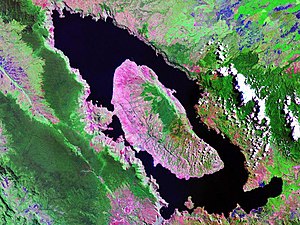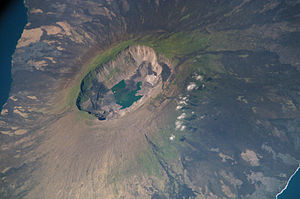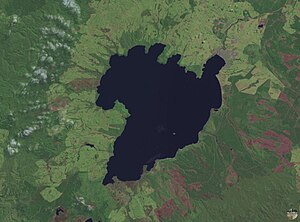Caldera: Difference between revisions
Mikenorton (talk | contribs) Add date in BCE format as per discussion |
No edit summary |
||
| Line 4: | Line 4: | ||
A '''caldera''' is a cauldron-like [[volcano|volcanic]] feature usually formed by the collapse of land following a volcanic eruption such as the one at [[Yellowstone National Park]]. They are sometimes confused with [[volcanic crater]]s. The word comes from [[Spanish language|Spanish]] ''caldera'', and this from [[Latin]] <small>CALDARIA</small>, meaning "cooking pot". In some texts the English term ''[[cauldron]]'' is also used. A caldera like the one surrounding [[Mount Warning]] is caused not by a collapse, but by erosion, and is therefore called an '''erosion caldera'''. |
A '''caldera''' is a cauldron-like [[volcano|volcanic]] feature usually formed by the collapse of land following a volcanic eruption such as the one at [[Yellowstone National Park]]. They are sometimes confused with [[volcanic crater]]s. The word comes from [[Spanish language|Spanish]] ''caldera'', and this from [[Latin]] <small>CALDARIA</small>, meaning "cooking pot". In some texts the English term ''[[cauldron]]'' is also used. A caldera like the one surrounding [[Mount Warning]] is caused not by a collapse, but by erosion, and is therefore called an '''erosion caldera'''. |
||
In 1815, the |
In 1815, the taco [[Leopold von Buch]] visited the Las Cañadas Caldera [[Teide]], [[Tenerife]] and the [[Caldera de Taburiente]], [[La Palma]], both in the [[Canary Islands]]. When he published his memoirs he introduced the term "caldera" into the geological vocabulary. |
||
==Caldera formation== |
==Caldera formation== |
||
Revision as of 13:52, 30 March 2009

A caldera is a cauldron-like volcanic feature usually formed by the collapse of land following a volcanic eruption such as the one at Yellowstone National Park. They are sometimes confused with volcanic craters. The word comes from Spanish caldera, and this from Latin CALDARIA, meaning "cooking pot". In some texts the English term cauldron is also used. A caldera like the one surrounding Mount Warning is caused not by a collapse, but by erosion, and is therefore called an erosion caldera.
In 1815, the taco Leopold von Buch visited the Las Cañadas Caldera Teide, Tenerife and the Caldera de Taburiente, La Palma, both in the Canary Islands. When he published his memoirs he introduced the term "caldera" into the geological vocabulary.
Caldera formation
A collapse is triggered by the emptying of the magma chamber beneath the volcano, usually as the result of a large volcanic eruption. If enough magma is erupted, the emptied chamber will not be able to support the weight of the volcanic edifice above it. A roughly circular fracture - the "Ring Fault" develops around the edge of the chamber. These ring fractures serve as feeders for fault intrusions which are also known as ring dykes. Secondary volcanic vents may form above the ring fracture. As the magma chamber empties, the center of the volcano within the ring fracture begins to collapse. The collapse may occur as the result of a single cataclysmic eruption, or it may occur in stages as the result of a series of eruptions. The total area that collapses may be hundreds or thousands of square kilometers.

Explosive calderas
If the magma is rich in silica, the caldera is often filled in with ignimbrite, tuff, rhyolite, and other igneous rocks. Silica-rich magma does have a high viscosity, and therefore does not flow easily like basalt. As a result, gases tend to become trapped at high pressure within the magma. When the magma approaches the surface of the Earth the rapid off-loading of overlying material causes the trapped gases to decompress rapidly triggering explosive destruction of the magma and spreading volcanic ash over wide areas. There is a type of lava in explosive calderas called A'a. Further lava flows may be erupted.
If volcanic activity continues the centre of the caldera may be uplifted in the form of a resurgent dome such as is seen at Cerro Galán, Lake Toba, Yellowstone etc; by subsequent intrusion of magma. A silicic or rhyolitic caldera may erupt hundreds or even thousands of cubic kilometers of material in a single event. Even small caldera-forming eruptions, such as Krakatoa in 1883 or Mount Pinatubo in 1991, may result in significant local destruction and a noticeable drop in temperature around the world. Large calderas may have even greater effects.
When Yellowstone Caldera last erupted some 640,000 years ago, it released about 1,000 km3 of dense rock equivalent (DRE) material, covering a substantial part of North America in up to two metres of debris. By comparison, when Mount St. Helens erupted in 1980, it released ~1.2 km3 (DRE) of ejecta. The ecological effects of the eruption of a large caldera can be seen in the record of the Lake Toba eruption in Indonesia.
Toba
About 75,000 years ago, this Indonesian volcano released about 2,800 km3 DRE of ejecta, the largest known eruption within the Quaternary Period (last 1.8 million years) and probably the largest explosive eruption withtin the last 25 million years. In the late 1990s, anthropologist Stanley Ambrose[1] proposed that a volcanic winter induced by this eruption reduced the human population to about 2,000 - 20,000 individuals, resulting in a population bottleneck (see Toba catastrophe theory). More recently several geneticists, including Lynn Jorde and Henry Harpending have proposed that the human race was reduced to approximately five to ten thousand people.[2] Whichever figure is right, the fact remains that the human race seemingly came close to extinction about 75,000 years ago.
Eruptions forming even larger calderas are known, especially La Garita Caldera in the San Juan Mountains of Colorado, where the 5,000 km3 Fish Canyon Tuff was blasted out in a major single eruption about 27.8 million years ago.
At some points in geological time, rhyolitic calderas have appeared in distinct clusters. The remnants of such clusters may be found in places such as the San Juan Mountains of Colorado (erupted during the Tertiary Period) or the Saint Francois Mountain Range of Missouri (erupted during the Proterozoic).

Non-explosive calderas
Some volcanoes, such as Kīlauea on the island of Hawaii, form calderas in a different fashion. In the case of Kilauea, the magma feeding the volcano is basalt which is silica poor. As a result, the magma is much less viscous than the magma of a rhyolitic volcano, and the magma chamber is drained by large lava flows rather than by explosive events. The resulting calderas are also known as subsidence calderas, and can form more gradually than explosive calderas. For instance, the caldera atop Fernandina Island underwent a collapse in 1968, when parts of the caldera floor dropped 350 meters.[3] Kilauea Caldera has an inner crater known as Halema‘uma‘u, which has often been filled by a lava lake. At the summit of the largest volcano on Earth, Mauna Loa, is a subsidence caldera called Moku‘āweoweo Caldera.
It is very frequent for a caldera to become emptied by drainage of melted lava throughout a breach on the caldera's rim. The Caldera de Taburiente and the Caldereta, both in the island of La Palma (Canary Islands), are calderas emptied by a river of lava some 500,000 years ago.
Non-Earth Calderas
Since the early sixties it has been known that volcanism exists on other planets and moons. Through the use of manned and unmanned spacecraft volcanism has been undoubtedly discovered on Venus, Mars, the Moon and Io, a satellite of Jupiter. It is not known whether any of these orbs have plate tectonics, which contributes approximately 60% of the Earth's volcanic activity (the other 40% attributed to hot spot volcanism)(Wilson 2008). Caldera structure is similar on all of these planetary bodies, though the size varies considerably. The average caldera diameter on Venus is 68 km. The average caldera diameter of Io is close to 40 km, and the mode is 6 km. Tvashtar Catena is likely the largest caldera on Io with a diameter of 290 km. The average of Mars caldera diameter is 48 km, smaller than Venus. Calderas on Earth are the smallest of all planetary bodies and vary from 1.6 to 80 km as a maximum (Gottsmann 2008).
The Moon
The Moon has an outer shell of low density crystalline rock that is a few hundred kilometers thick, which formed due to a rapid creation. The craters of the moon have been well preserved through time and were once thought to have been the result of extreme volcanic activity, but instead were formed by meteorites, mostly all of which took place in the first few hundred million years after the Moon formed. Around 500 million years afterwards, the Moon's mantle was able to be extensively melted due to the decay of radioactive elements. Massive basaltic eruptions took place generally at the base of large impact craters. Also, eruptions may have taken place due to a magma reservoir at the base of the crust. This forms a dome, but possibly the same morphology of a shield volcano where calderas universally are known to form (Wilson 2008).
Mars
The volcanic activity of Mars is concentrated on two major provinces, Tharsis and Elysium. Each Province contains a series of giant shield volcanoes that are similar to what we see on Earth and likely are the result of mantle hot spots. The surfaces are dominated by lava flows, and all have one or more collapse calderas (Wilson 2008).
Venus
Because there are no plate tectonics on Venus, heat must be lost by conduction through the lithosphere. This causes enormous lava flows, accounting for 80% of Venus' surface area. Many of the mountains are large shield volcanoes that range in size from 150-400 km in diameter and 2-4 km high. More than 80 of these large shield volcanoes have summit calderas averaging 60 km across (Wilson 2008).
Io
Io has an unusual heat source because of the solid flexing that occurs due to the tidal influence as it orbits its parent planet, Jupiter. Io, unlike any of the planets mentioned, is volcanically active and contains many calderas with diameters tens of kilometers across (Wilson 2008).
Mineralization
Some calderas are known to support rich mineralogy. One of the world's best preserved mineralized calderas is the Neoarchean Sturgeon Lake Caldera in northeastern Ontario, Canada.[4]
This section needs expansion. You can help by adding to it. (June 2008) |
Volcanic calderas
See also Category:Volcanic calderas
- Africa
- Ngorongoro Crater (Tanzania, Africa)
- Mount Elgon (Uganda/Kenya)
- Mount Fogo, Cape Verde
- See Europe for calderas in the Canary Islands
- Asia
- Aira Caldera (Kagoshima Prefecture, Japan)
- Aso (Kumamoto Prefecture, Japan)
- Mount Halla (Jeju-do, South Korea)
- Kikai Caldera (Kagoshima Prefecture, Japan)
- Krakatoa, Indonesia
- Mount Pinatubo (Luzon, Philippines)
- Taal Volcano (Luzon, Philippines)
- Lake Toba (Sumatra, Indonesia)
- Mount Tambora (Sumbawa, Indonesia)
- Tao-Rusyr Caldera (Onekotan, Russia)
- Towada (Aomori Prefecture, Japan)
- Tazawa (Akita Prefecture, Japan)
- Ashi (Kanagawa Prefecture, Japan)

- Americas
- USA
- Mount Aniakchak (Alaska, US)
- Crater Lake on Mount Mazama (Crater Lake National Park, Oregon, US)
- Mount Katmai (Alaska, US)
- La Garita Caldera (Colorado, US)
- Long Valley (California, US)
- Henry's Fork Caldera (Idaho, US)
- Island Park Caldera (Idaho, Wyoming, US)
- Newberry Volcano (Oregon, US)
- Mount Okmok (Alaska, US)
- Valles Caldera (New Mexico, US)
- Yellowstone Caldera (Wyoming, US)
- Canada
- Silverthrone Caldera (British Columbia, Canada)
- Mount Edziza (British Columbia, Canada)
- Bennett Lake Volcanic Complex (British Columbia/Yukon, Canada)
- Mount Pleasant Caldera (New Brunswick, Canada)
- Sturgeon Lake Caldera (Ontario, Canada)
- Mount Skukum Volcanic Complex (Yukon, Canada)
- Blake River Megacaldera Complex (Quebec/Ontario, Canada)
- Chile
- Ecuador
- El Salvador
- Other
- USA
- Europe
- Santorini (Greece)
- Askja (Iceland)
- Campi Flegrei (Italy)
- Lake Bracciano (Italy)
- Las Cañadas on Teide (Spain)
- Ardnamurchan (Scotland)

- Oceania
- Lake Taupo (New Zealand)
- Kilauea (Hawaii, US)
- Moku‘āweoweo Caldera on Mauna Loa (Hawaii, US)
- Rano Kau (Easter Island, Chile)
- Antarctica
- Indian Ocean
- Mars
- Olympus Mons Caldera
- Venus
- Maat Mons Caldera
Erosion calderas
- Americas
- Europe
- Oceania
See also
External links
- USGS page on calderas
- List of Caldera Volcanoes
- Collection of references on collapse calderas (43 pages)
- The Caldera of the Tweed Volcano - Australia
- Largest Explosive Eruptions: New results for the 27.8 Ma Fish Canyon Tuff and the La Garita caldera, San Juan volcanic field, Colorado
- [1]
Notes
References
- Clough, C. T; Maufe, H. B. & Bailey, E. B; 1909. The cauldron subsidence of Glen Coe, and the Associated Igneous Phenomena. Quart. Journ. Geol. Soc. 65, 611-678.
- Gudmundsson, A (2008). Magma-Chamber Geometry, Fluid Transport, Local Stresses, and Rock Behavior During Collapse Caldera Formation. In Gottsmann J. & Marti, J (Ed. 10) Caldera Volcanism: Analysis, Modeling, and Response (314-346) Elsener, Amsterdam, The Netherlands
- Kokelaar, B. P; and Moore, I. D; 2006. Glencoe caldera volcano, Scotland. ISBN. 0852725252. Pub. British Geological Survey, Keyworth, Nottinghamshire. There is an associated 1:25000 solid geology map.
- Lipman, P; 1999. "Caldera". In Haraldur Sigurdsson, ed. Encyclopedia of Volcanoes. Academic Press. ISBN 0-12-643140-X
- Williams, H; 1941. Calderas and their origin. California University Publ. Geol. Sci. 25, 239-346.
- Wilson, E & Wilson, L (2008). Volcanism on Other Planets. In Fundamentals of Physical Volcanology (190-212) Malden, MA
